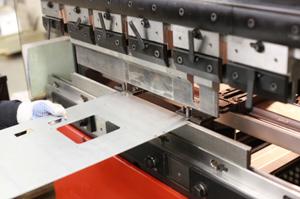 Français
Français
Manufacturer of Hydraulic Presses

Crash test safety standards for automobiles are constantly being monitored and adjusted—usually to more stringent levels. This is especially so for the parts of a vehicle that are likely to come under the most stress in an accident or collision—parts such as side-impact bars, front and rear fender beams, pillars, sill plates and roof seams. At the same time, automakers are always striving to reduce the weight of auto components for a variety of reasons, not least of which is the ongoing quest to achieve improved fuel economy.
It’s quite the challenge: Increase the strength of material while at the same time reduce its weight.
Part of the problem has been solved by automakers turning more and more towards the use of high-strength steel in the manufacturing process. But the real key to success lies in the process of hot press stamping, using a hydraulic press. The heated steel is stamped, using a water-cooled die to facilitate rapid cooling and the transformation from austenite to martensite. This process can increase the strength of materials by up to 150%.
This is just one example of how the flexibility of hydraulic presses drive manufacturing forward in one industry. Flexibility in slide speed, pressure dwell time and press force are standard features on most hydraulic presses, so it goes without saying that hydraulic presses are an important and useful machine to have at your disposal for a range of applications in a wide variety of industries.
RK Machinery is a hydraulic press specialist. The company prides itself on building quality, reliable and safe products. RK Machinery will custom-build hydraulic presses to your specifications, so contact them today to discuss your hydraulic press requirements.
From austenite to martensite explained
A unit cell of austenite is a perfect cube, but during the change to martensite, the cube becomes distorted—slightly longer in one dimension and shorter in the other two. This can only occur if the metal is cooled at the speed of sound. The distortion of the unit cell that occurs during this rapid cooling results in millions of lattice dislocations in each crystal—each one of which consists of millions of unit cells. These dislocations are what make the crystal structure extremely resistant to denting and scratching—and therefore dramatically improve the tensile strength of the metal.
http://www.fpef.org/
http://www.theglobeandmail.com/globe-drive/car-tips/safety/why-crash-test-ratings-matter/article2011598/